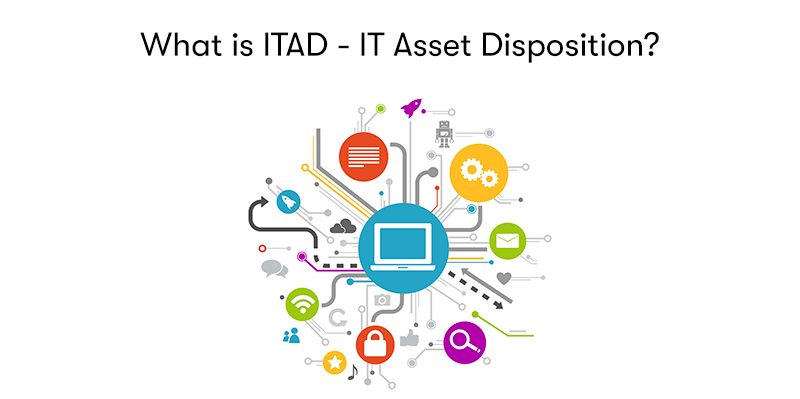What is ITAD - IT Asset Disposition?
Welcome to our exploration of IT Asset Disposition (ITAD), a critical and often overlooked aspect of modern business operations. In an era where technology rapidly evolves, and data security is paramount, understanding ITAD is no longer optional but essential.
ITAD involves the responsible and secure disposal of obsolete or surplus IT equipment, encompassing far more than just physical disposal. It's a practice deeply entwined with data protection, environmental sustainability, and regulatory compliance.
As organisations continuously upgrade their IT infrastructure, effective ITAD strategies become crucial in managing the lifecycle of IT assets, safeguarding sensitive data, and ensuring eco-friendly disposal practices. Join us as we delve into the complexities of ITAD, uncovering its significance in the ever-evolving landscape of information technology.
What is IT Asset Disposition?
IT Asset Disposition is a business practice that focuses on disposing of obsolete or unwanted IT equipment in a safe and ecologically responsible manner. The process involves several key steps:
Inventory Management
ITAD starts with a thorough inventory of all IT assets. This step helps understand what equipment is available and determine its condition and potential value.
Data Destruction
Before disposing of any IT equipment, it's crucial to erase all sensitive data. Data destruction can be done through software wiping, degaussing (demagnetising the data), or physical destruction of the hard drives.
Remarketing
Functional and valuable IT assets can be resold in the secondary market. This not only recoups some of the initial investment but also extends the life of the equipment, promoting sustainability.
Recycling
Equipment that can't be reused or sold is recycled. This process involves breaking down the components and safely extracting valuable materials like metals while properly disposing of harmful substances.
Regulatory Compliance
ITAD must comply with various local, national, and international regulations regarding data security and environmental protection. This includes laws like GDPR for data protection and the EU's WEEE Directive for waste electrical and electronic equipment.
Documentation and Reporting
Proper documentation is provided for all steps of the ITAD process. This includes certificates of data destruction, records of equipment sold or recycled, and compliance reports.
The goal of ITAD is not only to dispose of IT assets in a way that minimises harm to the environment but also to ensure that all data on these assets is securely and permanently destroyed to protect the organisation from data breaches. Additionally, it helps organisations free up space and resources for new technology, aligns with corporate social responsibility goals, and ensures compliance with various legal and environmental standards.
What Are Assets in IT?
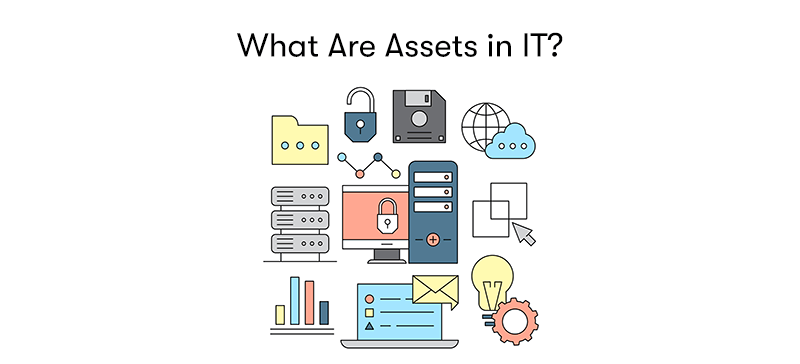
In Information Technology (IT), assets are any items of value owned by an organisation related to its technology and information systems. These assets can be categorised into various types:
Hardware
This includes physical devices and equipment such as computers (desktops, laptops), servers, networking devices (routers, switches), printers, and other peripherals. Mobile devices like smartphones and tablets are also considered IT hardware assets.
Software
Software assets are the programs and applications used in an organisation. This includes operating systems, office productivity tools, database software, specialised applications, and custom-developed software. Software licenses are also considered part of software assets.
Data
Arguably the most valuable IT asset, data encompasses the information stored, processed, and transmitted by an organisation. This includes customer data, financial records, intellectual property, employee information, and other business-critical data.
Network Assets
These components make up an organisation's IT network infrastructure, including hardware (like routers and switches) and software (such as network management software and security tools).
Cloud Resources
With the rise of cloud computing, resources hosted on external cloud platforms (like servers, storage, applications, and services) are increasingly considered vital IT assets.
Intangible Assets
This includes domain names, websites, and other digital properties. It also covers aspects like software licenses and subscriptions.
IT Documentation
Documentation of IT systems, configurations, and processes is also an important asset. This includes network diagrams, user manuals, policy documents, and standard operating procedures.
Human Resources
The skills, expertise, and knowledge of the IT staff are sometimes considered intangible IT assets because they play a critical role in managing and utilising other IT assets effectively.
Effective IT asset management is crucial for any organisation as it helps track, evaluate, and manage these assets throughout their lifecycle, ensuring optimal utilisation and security and aiding in strategic decision-making regarding IT investments.
Why is ITAD Important?
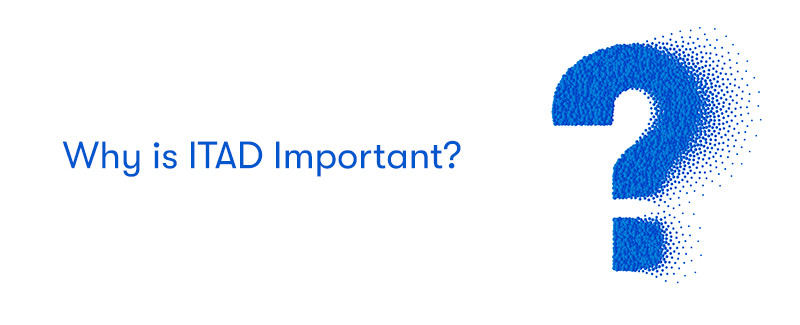
IT Asset Disposition is essential for several reasons, all of which are significant for organisations in managing their IT infrastructure, data security, legal compliance, and environmental responsibilities:
Data Security
One of the primary concerns in disposing of IT assets is ensuring that sensitive data is destroyed. ITAD provides systematic processes for data destruction, preventing data breaches and protecting against identity theft, corporate espionage, and other security risks.
Legal and Regulatory Compliance
Organisations must comply with various laws and regulations regarding data protection (like GDPR) and environmental standards (like the WEEE Directive). Non-compliance can result in hefty fines and legal penalties. ITAD ensures that asset disposition adheres to these legal requirements.
Environmental Responsibility
Proper disposal of IT equipment is crucial for environmental sustainability. ITAD promotes the recycling and repurposing of electronic components, reducing e-waste and preventing hazardous materials from harming the environment.
Cost Management
Through ITAD, organisations can recover some value from their outdated or excess equipment via resale or recycling, turning potential waste into a source of revenue. This process also reduces the costs associated with storing and maintaining obsolete equipment.
Corporate Reputation
Proper ITAD practices reflect a company's commitment to data security and environmental stewardship, enhancing its reputation among customers, partners, and regulatory bodies.
Risk Management
By securely and responsibly disposing of IT assets, organisations mitigate risks associated with data privacy breaches, environmental damage, and non-compliance with regulations.
Resource Optimisation
ITAD helps identify underutilised assets that can be redeployed or repurposed within the organisation, optimising the use of IT resources.
Strategic Planning
Effective ITAD processes provide insights into the lifecycle of IT assets, aiding in strategic planning for future IT investments and infrastructure upgrades.
In summary, ITAD is not just a necessary business practice for legal and regulatory compliance; it also plays a crucial role in protecting sensitive data, managing costs, preserving the environment, and maintaining a company's reputation. It's a comprehensive approach to managing the end-of-life of IT assets that aligns with broader business objectives and ethical responsibilities.
How Does ITAD Relate to ITAM?
IT Asset Disposition (ITAD) and IT Asset Management (ITAM) are closely related but distinct aspects of an organisation's overall approach to managing its IT assets.
IT Asset Management
ITAM is a comprehensive strategy that encompasses the entire lifecycle of an organisation's IT assets. This includes procurement, deployment, maintenance, utilisation, and eventual disposal or repurposing of IT assets. The primary goal of ITAM is to optimise the value and usage of IT assets while managing costs and risks. ITAM involves tracking and managing hardware, software, and other technological resources, ensuring they are effectively used, maintained, and upgraded as needed.
IT Asset Disposition
ITAD deals explicitly with the end-of-life phase of IT assets. It focuses on the safe, secure, and environmentally responsible disposal, recycling, or repurposing of IT equipment that is no longer needed or has become obsolete. ITAD includes data destruction, e-waste recycling, and the resale or donation of usable equipment. The key concerns are data security, legal compliance, and environmental sustainability.
Relationship between ITAD and ITAM
Lifecycle Management: ITAD is essentially the final stage in the ITAM process. While ITAM covers the entire lifecycle of IT assets, ITAD steps in when these assets reach their end of life.
Risk Management: Both ITAM and ITAD are crucial for risk management. ITAM helps in mitigating risks associated with the utilisation of IT assets, such as inefficiencies, unnecessary costs, or security vulnerabilities. ITAD addresses risks related to data breaches, non-compliance with legal and environmental regulations, and reputation damage at the disposal phase.
Cost Efficiency: Effective ITAM can reduce overall costs by optimising the use of IT assets. Similarly, ITAD can mitigate costs associated with the end-of-life process, such as storage, maintenance of obsolete assets, and potential fines for non-compliance.
Data Security: Data security is a critical aspect of ITAM and ITAD. While ITAM ensures data is protected while using assets, ITAD ensures data is securely destroyed or wiped when assets are disposed of.
Strategic Planning: Both contribute to strategic planning within an organisation. ITAM provides insights for future IT investments and asset utilisation, while ITAD offers a responsible approach to decommissioning and replacing old assets.
In summary, ITAM and ITAD are integral parts of a holistic approach to IT asset lifecycle management, each addressing different stages but interconnected in ensuring efficient, secure, and responsible use and disposal of IT assets.
What is the Circular Economy Relating to IT Asset Disposition?
When applied to IT Asset Disposition, the concept of a circular economy represents a shift from the traditional linear model of 'make, use, dispose' to a more sustainable, circular approach. In the context of ITAD, this involves extending the lifecycle of IT assets and ensuring their value is maximised through reuse, refurbishment, and recycling. Here's how ITAD aligns with the principles of a circular economy:
Extending Lifecycles
Instead of disposing of IT assets when they are no longer needed or become outdated, ITAD focuses on extending their useful life in a circular economy. This can be done by refurbishing, upgrading, or repurposing IT equipment.
Resale and Reuse
ITAD processes include the resale of functional IT assets in the secondary market. This provides an opportunity for smaller organisations to access technology at a lower cost and reduces waste by keeping these assets in use.
Recycling
When IT assets can no longer be used, ITAD ensures they are recycled responsibly. This process involves breaking down the equipment to recover valuable materials like metals, plastics, and rare earth elements, which can then be reused to manufacture new products.
Reducing E-Waste
By promoting the reuse and recycling of IT assets, ITAD, in a circular economy, significantly reduces e-waste, helping to alleviate its environmental impact.
Resource Efficiency
A circular approach in ITAD encourages more efficient use of resources. It reduces the demand for raw materials, as recycled components are reused, and decreases the overall environmental footprint of manufacturing new IT equipment.
Data Security and Compliance
Even within a circular economy, ITAD must maintain data security and regulatory compliance. Secure data destruction is critical to ensuring that data privacy is preserved even when assets are refurbished or recycled.
Supporting Sustainability Goals
Organisations increasingly recognise the importance of sustainable practices. Implementing ITAD strategies that align with the principles of a circular economy supports these sustainability goals and can enhance a company's reputation and corporate social responsibility initiatives.
In summary, applying the principles of a circular economy to ITAD transforms the way organisations handle their end-of-life IT assets. It emphasises reducing waste, maximising resource efficiency, and minimising environmental impact, all while ensuring data security and compliance with regulations. This approach not only benefits the environment but also offers economic and social advantages.
Security Concerns and IT Asset Disposition
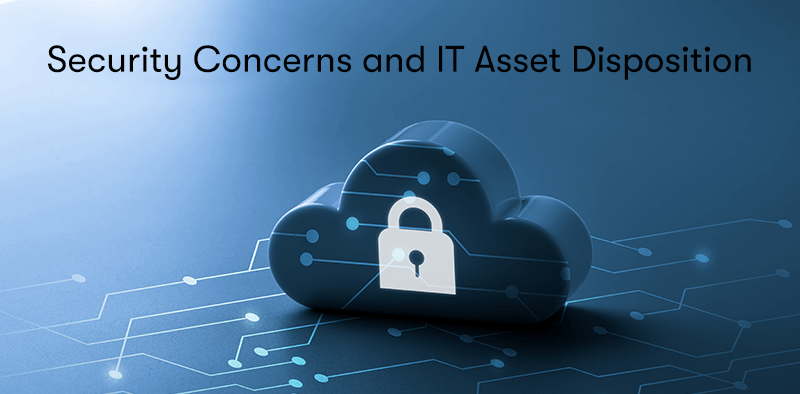
Security concerns in IT Asset Disposition are critical, as mishandling of IT assets at the end of their lifecycle can lead to significant risks, especially regarding data privacy and security. Here are some key security concerns in ITAD:
Data Breaches
The most significant risk is the potential for data breaches. IT assets often contain sensitive information, including customer data, employee records, business secrets, and financial information. If data is not destroyed correctly or wiped before disposal, it can fall into the wrong hands.
Compliance Violations
Various regulations, such as the General Data Protection Regulation (GDPR) in Europe, mandate strict controls over how personal and sensitive data is handled and disposed of. Non-compliance can result in hefty fines and legal penalties.
Software Licensing Issues
Improper disposal of assets can also lead to software licensing violations. If assets with licensed software are sold or given away without proper license transfers, it could violate software licensing agreements.
Physical Security of Assets
The physical security of assets during the disposition process is also a concern. This includes secure transportation and storage of assets to prevent theft or loss.
Reliable Data Destruction
Choosing appropriate and effective methods for data destruction is crucial. Methods like data wiping, degaussing, or physical destruction of hard drives should be selected based on the sensitivity of data and the type of storage device.
Vendor Trustworthiness
Outsourcing ITAD processes requires trusting third-party vendors. Ensuring these vendors follow stringent security protocols and have a good track record in handling sensitive data is vital.
Environmental Compliance Risks
There's also a risk of non-compliance with environmental regulations. Improper disposal methods can lead to environmental damage and legal consequences.
Record Keeping and Documentation
Maintaining accurate records of the disposal process is essential for compliance and audit purposes. Lack of proper documentation can lead to issues in demonstrating compliance with data protection and environmental laws.
Internal Policy Adherence
Ensuring that internal data security and asset disposal policies are consistently followed is crucial to prevent security lapses.
Organisations should have a comprehensive ITAD policy addressing data security, legal compliance, environmental stewardship, and risk management to mitigate these concerns. Regular audits and working with certified ITAD service providers can also help ensure the IT asset disposition process is secure and compliant.
The Legal Aspects of ITAD
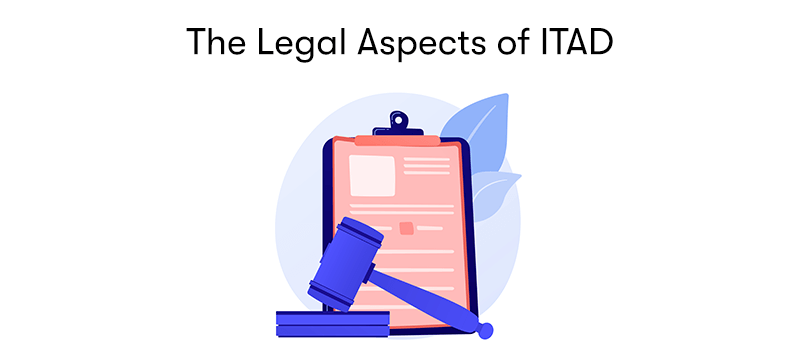
The legal aspects of IT Asset Disposition are crucial for organisations to consider, as non-compliance can lead to significant legal, financial, and reputational consequences. These legal aspects often revolve around data protection, environmental regulations, and corporate governance. Here are some key legal considerations in ITAD:
Data Protection and Privacy Laws
Laws like the General Data Protection Regulation (GDPR) in the European Union, the California Consumer Privacy Act (CCPA), and similar regulations impose strict rules on how personal data should be handled and disposed of. Organisations must ensure that data on IT assets is securely destroyed or wiped to avoid penalties for data breaches.
Environmental Regulations
ITAD must comply with environmental laws governing electronic waste disposal and recycling. This includes directives like the Waste Electrical and Electronic Equipment Directive (WEEE) in Europe, the Resource Conservation and Recovery Act (RCRA) in the US, and other regional or country-specific regulations. These laws are designed to prevent harmful substances in electronics from damaging the environment.
Export and Import Laws
The Basel Convention and other international agreements regulate the cross-border movement of hazardous waste, including e-waste. Organisations must ensure compliance when exporting IT assets for disposal or recycling abroad.
Corporate Compliance Policies
Beyond external legal requirements, organisations often have internal compliance policies related to asset management and disposal. Adherence to these policies is crucial to maintaining corporate governance standards and avoiding internal legal issues.
Software Licensing Agreements
Compliance with software licensing terms is another legal aspect. Organisations must ensure that software licenses are properly terminated or transferred when disposing of assets, according to the license agreement terms.
Record Keeping and Documentation
Proper documentation of the ITAD process is essential for legal and compliance reasons. This includes records of data destruction certificates, environmental disposal compliance, and transfer of ownership for resold assets.
Contractual Obligations with ITAD Vendors
If an organisation outsources ITAD to third-party vendors, it's critical to ensure that these vendors comply with all relevant laws and regulations. Contracts should clearly outline the responsibilities and expectations for legal compliance.
Intellectual Property Considerations
When disposing of IT assets, care must be taken to ensure that any intellectual property contained on these assets is securely removed or destroyed.
Organisations must navigate these legal aspects carefully and typically benefit from consulting with legal experts in data privacy, environmental law, and corporate compliance to ensure complete adherence to the myriad of rules and regulations governing ITAD.
Reusing and Recycling

IT Asset Disposition incorporates reusing and recycling of IT equipment, each serving an essential role in the lifecycle management of IT assets. Here's a detailed look at these two aspects:
Reusing
Reusing is an integral part of ITAD and aligns with the principles of a circular economy. It involves extending the life of IT assets through various means:
Refurbishing: IT assets that are no longer needed but still functional can be refurbished. This process includes cleaning, repairing, and possibly upgrading the equipment to make it suitable for further use.
Resale: Refurbished IT assets can be sold in the secondary market. This allows organisations to recoup some of their initial investment and for smaller businesses or individuals to purchase technology at a lower cost.
Redeployment: Often, IT assets can be reused within the same organisation. Equipment no longer needed in one department might still be useful in another, helping to optimise the organisation's overall IT budget.
Donation: Companies may donate their used IT equipment to educational institutions, non-profits, or other organisations that might benefit from them.
Recycling
Recycling is the process of breaking down IT assets that are no longer viable for reuse and extracting valuable materials for the production of new products:
Material Recovery: IT equipment contains various valuable materials like metals (gold, silver, copper), plastics, and rare earth elements. Recycling involves recovering these materials so they can be used again, reducing the need for new raw materials.
Environmental Protection: Proper recycling of IT assets prevents harmful substances (like lead, mercury, and cadmium) found in electronic waste from contaminating the environment.
Compliance with Regulations: Recycling IT assets must comply with environmental regulations like the WEEE Directive in Europe and the US Resource Conservation and Recovery Act (RCRA), which dictate how e-waste should be handled and processed.
Specialised Recycling Vendors: Organisations often work with specialised ITAD vendors who ensure that IT assets are recycled in an environmentally responsible manner and compliant with relevant laws and regulations.
Certification Standards: There are certifications like R2 (Responsible Recycling) and e-Stewards that set standards for responsible recycling of e-waste. Working with certified recyclers ensures that the recycling process adheres to high environmental and safety standards.
Integration of Reusing and Recycling in ITAD
Integrating reusing and recycling in ITAD is crucial for maximising the value and minimising the environmental impact of end-of-life IT assets. While reusing extends the useful life of IT equipment, recycling ensures the safe and sustainable handling of assets that can no longer be used. Together, they form an essential part of a responsible and efficient ITAD strategy, contributing to both economic and environmental sustainability.
What is the ITAD Market?
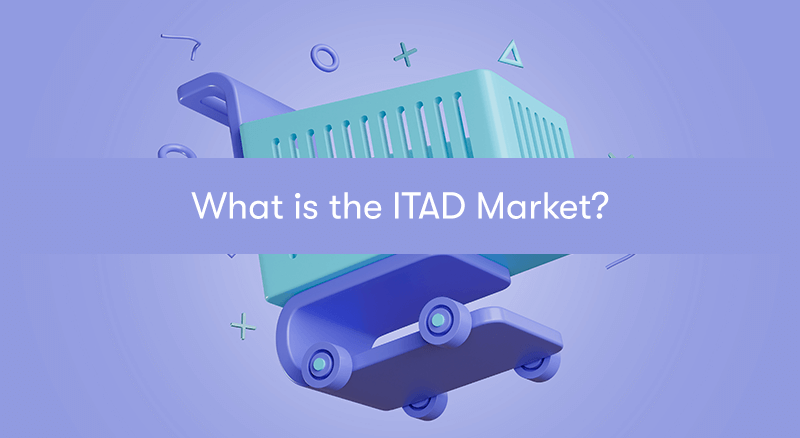
The IT Asset Disposition market refers to the industry and services surrounding the safe, responsible, and compliant disposal or repurposing of outdated or unwanted IT equipment. This market has grown significantly in recent years due to various factors, including the rapid pace of technological advancements, increasing focus on data security, and stringent environmental regulations. Key aspects of the ITAD market include:
Service Providers
The ITAD market consists of specialised service providers who offer a range of services related to the disposal of IT assets. These services typically include data destruction, recycling, refurbishing, remarketing, and logistics management.
Clientele
The market serves a wide range of clients, from small businesses to large corporations, government entities, and educational institutions. Any organisation that uses IT equipment is a potential client for ITAD services as they eventually need to dispose of or repurpose their hardware.
Market Drivers
Technological Advancements: Rapid technology changes lead to shorter lifecycles for IT equipment, driving demand for ITAD services.
Data Security Concerns: With increasing threats of data breaches, companies prioritise secure disposal of IT assets to protect sensitive information.
Regulatory Compliance: Stricter regulations on data protection and environmental standards compel organisations to seek professional ITAD services to ensure compliance.
Environmental Awareness: Growing awareness about the environmental impact of e-waste encourages companies to adopt sustainable practices in disposing of IT assets.
Global Scope
The ITAD market operates globally, with different regions having varying regulations and market dynamics. The US, Europe, and Asia-Pacific regions are particularly significant markets due to their large IT industries and stringent regulatory frameworks.
Value-Added Services
Many ITAD providers offer value-added services such as detailed reporting, certification of data destruction, and environmental compliance documentation to add more value to their clients.
Market Trends
Increased Use of Cloud Computing: As more organisations move to cloud services, there's a shift in the types of hardware being disposed of and repurposed.
Growth in Remote Work: The rise in remote working trends affects the types and volumes of IT assets organisations need to manage.
Focus on Circular Economy: There's a growing emphasis on extending the life of IT assets through refurbishment and resale, in line with circular economy principles.
Challenges
The ITAD market faces challenges such as ensuring global compliance with diverse regulations, managing asset collection and processing logistics, and staying abreast of technological changes affecting asset value and disposal methods.
Overall, the ITAD market plays a crucial role in helping organisations manage the end-of-life of their IT assets in a secure, compliant, and environmentally responsible manner. This market is expected to continue growing as technology evolves, and the focus on data security and environmental sustainability intensifies.
IT Asset Disposition Companies UK
Several companies in the UK specialise in IT Asset Disposition services. These companies offer a range of solutions, including secure data destruction, hardware recycling, and refurbishing. Some notable examples include:
Tier1
Tier1 has operated in the IT asset disposal industry since 1995, offering a range of services, including IT disposal, data destruction, and recycling.
S2S Group
Based in South Yorkshire, S2S Group offers ITAD services, including secure data destruction, IT recycling, and asset recovery. They are known for their focus on security and environmental compliance.
N2S
N2S, based in Bury St Edmunds, offers ITAD services emphasising reducing e-waste through innovative recycling techniques. They provide secure data wiping, asset refurbishment, and recycling.
Techbuyer
Operating from Harrogate, Techbuyer specialises in the refurbishment and resale of IT equipment alongside ITAD services. They focus on extending the lifecycle of IT assets through refurbishing and reselling.
Stone Group
Stone Group in Stafford offers a comprehensive range of ITAD services, including secure disposal, data destruction, and equipment recycling. They cater to various sectors, including education, healthcare, and business.
Greenbox IT Disposal
Operating from Liverpool, Greenbox IT Disposal offers secure IT asset disposal services, focusing on data security and environmentally friendly recycling practices.
Can You Outsource Your IT Asset Disposition Responsibilities?
Yes, you can outsource your IT Asset Disposition responsibilities to specialised service providers. In fact, outsourcing ITAD is a common practice for many organisations, from small businesses to large corporations. Here are some key points to consider about outsourcing ITAD:
Advantages of Outsourcing ITAD
Expertise and Experience: ITAD service providers have specialised knowledge and experience in handling the complex asset disposition process, including data destruction, recycling, and compliance with legal regulations.
Resource Efficiency: Outsourcing allows an organisation to focus on its core business activities, leaving the intricate and time-consuming process of ITAD to experts.
Compliance and Risk Management: Professional ITAD providers are well-versed in compliance with data protection laws and environmental regulations, reducing the risk of legal and financial penalties for your organisation.
Data Security: ITAD vendors often employ advanced techniques for data destruction and provide certificates of destruction, ensuring that sensitive data is securely and permanently erased.
Environmental Responsibility: ITAD companies typically follow environmentally responsible practices for recycling and disposing of e-waste, aligning with sustainability goals.
Cost-Effectiveness: Outsourcing can be more cost-effective than managing ITAD in-house, especially when considering the investment in equipment, technology, and training required for proper ITAD.
Considerations When Outsourcing ITAD
Selecting the Right Vendor: Choosing a reputable and reliable ITAD provider is crucial. Look for certifications such as R2 (Responsible Recycling), e-Stewards, or ISO standards that indicate compliance with industry best practices.
Understanding Service Agreements: Clearly understand the terms of service, including data destruction methods, recycling processes, and the handling of logistics.
Data Security Protocols: Ensure the vendor follows stringent data security protocols to prevent data breaches during the disposition process.
Audit and Reporting: Choose providers who offer detailed reporting and audit trails for each phase of the ITAD process, providing transparency and documentation for compliance purposes.
Costs and Value Recovery: Consider outsourcing costs and evaluate if the provider offers any value recovery opportunities through resale or refurbishing of assets.
Vendor's Environmental Practices: Confirm that the provider adheres to environmental regulations and practices eco-friendly disposal and recycling of e-waste.
Outsourcing ITAD can be a strategic decision that ensures compliance and data security and contributes to an organisation's efficiency and sustainability goals. However, conducting thorough due diligence is important when selecting an ITAD provider to ensure they meet your specific needs and standards.
Final Notes on IT Asset Disposition
In conclusion, our exploration of IT Asset Disposition highlights its critical role in the modern business landscape. As we've seen, ITAD is not merely about disposing of outdated technology; it's a comprehensive practice encompassing data security, environmental responsibility, and legal compliance. By understanding the interplay between ITAD and IT Asset Management (ITAM), organisations can better manage the lifecycle of their IT assets.
The growing emphasis on the circular economy within ITAD underscores a commitment to sustainable practices. For many businesses, outsourcing ITAD offers a practical solution, leveraging expertise to navigate complex data protection laws and e-waste regulations. As technology evolves rapidly, embracing effective ITAD strategies remains pivotal for operational efficiency, risk management, and fostering a culture of sustainability and responsibility.


